Menu
Ontario's sports timeline
11,000 to 85,000 years ago
Wisconsinan glaciation was the most recent advance of the North American glaciers. It marked the last glaciers that receded from southern Ontario.
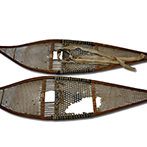
Anthropologists believe that people first migrated from Central Asia and Russia over the Bering Strait to Canada by the use of snowshoes. (Snowshoes, from the Ontario Heritage Trust Collection, Homewood Museum, Maitland, Ontario.)
1,400 to 1,200 years ago
Ontario Iroquoian people began to farm the “three sisters:” corn, beans and squash.
900 to 1,200 years ago
Aborginal peoples left pictographs and petroglyph images of canoes on rocks in the Peterborough area and parts of northern Ontario.
1615
Étienne Brûlé, a French explorer, led the way into Ontario for Samuel de Champlain. He travelled along the Ottawa, Mattawa and French rivers to reach Georgian Bay and Huronia.
1637
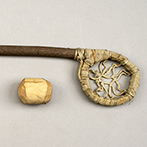
Jesuit Missionary Jean de Brébeuf (1593-1649) witnessed the Iroquois playing lacrosse. He was the first to record the game and described the sometimes brutal sport as a spiritual game. (Lacrosse stick and ball, Anishnaabe (Ojibwa). Lac Seul Reserve,Ontario. Wood and animal hide. Photo courtesy of the Canadian Museum of History collection. III-G-359 a,b, D2002-013530)
1670
The Hudson’s Bay Company began trading in lands that would become Ontario.
1791
The British province of Upper Canada was established, which generally comprised southern Ontario.
September 1793
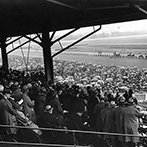
Elizabeth Simcoe, wife of Lieutenant Governor John Graves Simcoe, informally inaugurated horse racing on a straight track located on Toronto Island. (Opening day at Woodbine Racetrack, 1926. Photo courtesy of the City of Toronto Archives.)
1812-14
The War of 1812, fought between the United States and Britain, included several significant battles on Ontario soil.
1820
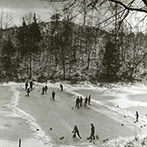
The first curling club in Ontario – the Royal Kingston Curling Club – is formed. (Curling in Toronto’s High Park, 1913. Credit: John Boyd. Photo courtesy of the Archives of Ontario.)
1837
The rebellion in Upper and Lower Canada led to the passing of the Act of Union in 1840.
June 1838
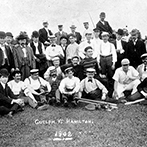
Baseball is played for the first time in Beachville, Ontario (between Oxford and Zorra townships). Back then, the game featured five bases, players used a hand-hewn stick as a bat, and the ball was made of twisted yarn covered in calf skin. (Guelph vs. Hamilton, 1902. Photo courtesy of the Guelph Public Library Archives, F38-0-15-0-0-292.)
July 1, 1867
Canadian Confederation. The provinces of Ontario, Quebec, Nova Scotia and New Brunswick formed the Dominion of Canada. John A. Macdonald was the first Prime Minister.
September 1867
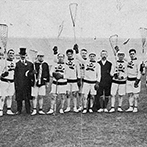
At a lacrosse convention held in Kingston, the rules were codified and the National Lacrosse Association was formed. (Canadian Olympic lacrosse team, 1908. Photo courtesy of Library and Archives Canada.)
1872
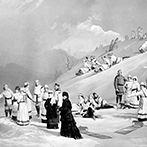
Governor General Lord Dufferin added a toboggan slide at Rideau Hall for the public to enjoy. (The Toboggan Party, Rideau Hall. Illuminated composite photograph from the personal album of Lady Dufferin, c. 1872-75. Photo courtesy of Library and Archives Canada.)
October 1873
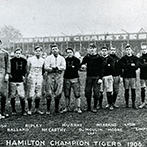
Toronto Argonauts Football Club played their first game against the Hamilton Tigers. (Hamilton Tigers team photograph, 1906. Photo courtesy of the Hamilton Public Library.)
1875
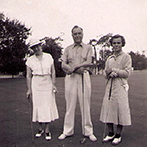
Niagara-on-the-Lake Golf Club was founded by John Gaele Dickson. (Josephine Fulford and friends golfing. Ontario Heritage Trust Collection, Fulford Place, Brockville, Ontario.
1881
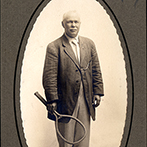
The first Canadian Tennis Open Championships were held at the Toronto Lawn Tennis Club. (Man with racket, c. 1880s-1900. Ontario Heritage Trust Collection, Homewood Museum, Maitland, Ontario.)
1889
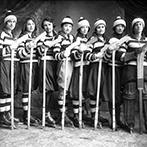
The first official women’s hockey game was played in Ottawa. The Government House team defeated the Rideau ladies team. (Girls’ hockey team, c. 1900s. Credit: George Irwin. Photo courtesy of the Archives of Ontario.)
December 1891
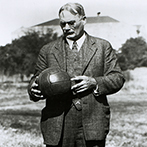
Dr. James Naismith invents the game of basketball, nailing two peach basket to the gym balconies at the International YMCA training school. He published 13 rules for the game in the school’s newspaper The Triangle. (Dr. James Naismith holding a basketball, standing beside two peach baskets (goals), c. 1930s. Photo courtesy of the Kansas University Archives.)
1893
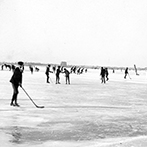
Governor General Lord Stanley donated a trophy to the emerging sport of hockey. Ottawa was the first Ontario team to win the Stanley Cup in 1903. (Playing Hockey on the St. Clair River in Sarnia. Credit: John Boyd. Photo courtesy of the Archives of Ontario.)
1900
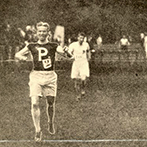
George Orton of Strathroy, Ontario, won a gold medal at the Paris Olympics in 1900 in the 2,500-metre steeplechase for the United States before Canada had an Olympic team. (George Washington Orton (1873-1958) winning his Olympic gold medal, July 1900. Photo courtesy of the University of Pennsylvania Archives.)
1904
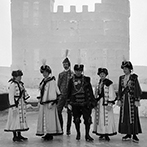
The Minto Skating Club is founded in Ottawa. Its patrons were Lord Minto, Governor General of Canada, and the Countess of Minto. It is now the oldest skating club in Ontario. (Lord and Lady Minto with a group in front of the Ice Palace, Ottawa, March 1904. Photo courtesy of Library and Archives Canada.)
1909
Five-pin bowling was invented by Thomas Ryan in his Toronto pool hall after complaints of the weight of 10-pin balls.
1909
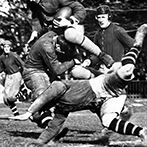
The first Grey Cup was played at Toronto’s Rosedale Field. (The First Grey Cup – December 4, 1909. Photo courtesy of The Globe and Mail.)
May 24, 1913
At 56-1 odds of winning, three-year-old Rockspring of Hamilton placed 9th in the King’s Plate at Woodbine Park. He had six career wins before he became a warhorse in the First World War. Watch a video from the 154th Queen’s Plate in tribute to Rockspring here.
August 4, 1914
Great Britain declared war on Germany. Canada, as part of the British Empire, was drawn into the conflict of the First World War.
September 1914
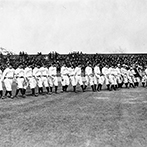
Legendary baseball player Babe Ruth hits his first home run in professional baseball at Maple Leaf Park, near Hanlan’s Point. He was a
19-year-old rookie playing for the Providence Grays. (Toronto baseball team, c. 1910. Hanlan’s Point Stadium. Photo courtesy of the City of Toronto Archives.)
1919
The Ontario Hockey Association (OHA) donated the OHA Memorial Cup in remembrance of all the soldiers who died in the First World War.
February 1923
Foster Hewitt did his first live radio hockey broadcast at the Arena Gardens (Mutual Street Arena) in Toronto.
1926
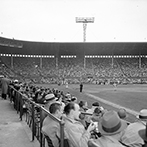
Maple Leaf Stadium was built in Toronto and witnessed a winning year of baseball. The Toronto Maple Leafs won the Junior World Series, defeating the Louisville Colonels 5-0. (Baseball game at Toronto’s Maple Leaf Stadium. Photo courtesy of the City of Toronto Archives.)
1927
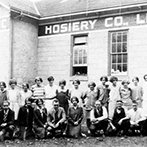
Guelph Elastic Hosiery added a hard cup to the jockstrap for extra protection. It was sold for years under the name Protex. (Guelph Elastic Hosiery Ltd., c. 1920s. Photo courtesy of the Guelph Public Library Archives, F38-0-7-0-0-84.)
October 29, 1929
Black Tuesday occurred – triggering the stock market collapse that led to the Great Depression of the 1930s.
August 1930
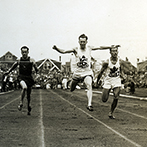
Hamilton was host to the first Commonwealth Games (then known as the British Empire Games). Eleven countries sent 400 athletes to participate in 59 events. (Canadian Percy Williams winning the 100-yard dash at the British Empire Games in Hamilton, 1930. Photo courtesy of the Hamilton Public Library.)
November 1931
Maple Leaf Gardens opened with its first hockey game between the Toronto Maple Leafs and the Chicago Blackhawks. Over 13,000 people were in attendance.
December 11, 1931
Through the Statute of Westminster, an act of Parliament of the United Kingdom, Canada became its own free dominion separate from Great Britain.
August 16, 1933
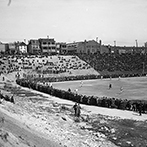
The Christie Pits riots occurred following a softball game at Willowdale Park between the St. Peter’s baseball team and the Harbord Playground, a predominantly Jewish team. Nazi sympathizers unveiled at the park a large sheet that had a swastika on it, causing uproar among the young, Jewish men. Hundreds fought in and around the park for six hours. (Willowdale Park baseball game, May 1922. Photo courtesy of the City of Toronto Archives.)
1938
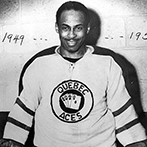
Herbert Carnegie was denied a chance to play in the National Hockey League due to the colour of his skin. Conn Smythe would have considered signing Carnegie to the Toronto Maple Leafs if it were not for the race barrier that existed then in professional hockey. (Herbert Carnegie, Quebec Aces, c. 1949-53. Photo courtesy of the Multicultural Society of Ontario. BLA-200511-1516.)
September 10, 1939 to September 2, 1945
Canada declared war on Nazi Germany and joined the Second World War, alongside its ally Great Britain.
November 1946
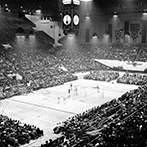
The first game of the first season of the National Basketball Association (NBA) was played at Maple Leaf Gardens between Toronto and New York. (NBA basketball game, Maple Leaf Gardens, January 1946. Photo courtesy of the City of Toronto Archives.)
November 1952
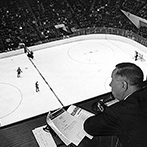
Hockey Night in Canada made its national television debut on the CBC with a game between the Toronto Maple Leafs and the Boston Bruins. Foster Hewitt was the first English broadcaster. (Hockey Night in Canada. Photo courtesy of the CBC Still Photo Collection. Credit: Robert Ragsdale.)
July 1, 1958
The Trans-Canada microwave system was completed. It was the largest system in the world at the time.
1964
Northern Dancer, owned by Toronto’s E.P Taylor, became the first Canadian-bred and -owned horse to win the Kentucky Derby.
February 15, 1965
The national flag of Canada was introduced to replace the Union Jack. The new design featured a red field with a white square centre containing a large red maple leaf in the middle.
June 1969
The first Special Olympics event was held in Toronto, with 1,400 participants from across Canada.
September 28, 1972
Team Canada defeated the Soviet Union in the Summit Series, with Paul Henderson scoring the winning goal – with only 34 seconds left in the game.
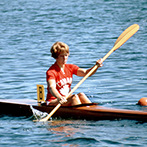
1976
Ottawa's Sue Holloway became the first Canadian athlete to compete in both the Summer and Winter Olympic Games in the same year for cross-country ski relay and canoe racing. (Sue Holloway, 1976 Summer Olympics in Montreal. Photo courtesy of the Canadian Olympic Committee.)
April 7, 1977
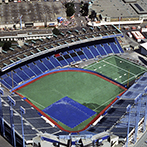
The Toronto Blue Jay’s first game at Exhibition Stadium in Toronto against the Chicago White Sox to a cheering crowd of 44,649 fans was won by the Jays 9-5. (Toronto Baseball Stadium, c. 1977. Photo courtesy of the City of Toronto Archives.)
1982
Canada’s Constitution Act was signed by Her Majesty Queen Elizabeth II and Prime Minister Pierre Elliott Trudeau. With it came the Canadian Charter of Rights and Freedoms.
1982
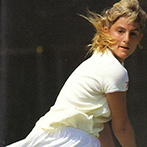
Toronto’s Carling Bassett was the only Canadian to have broken into the top 10 singles on the professional tennis tour during the century. (Carling Bassett. Photo courtesy of Tennis Canada.)
1984
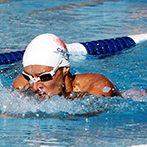
Canadian swimmers Alex Baumann and Victor Davis both won gold medals in swimming at the 1984 Summer Olympics in Los Angeles. Baumann, the flag bearer for the Games, won gold in the men’s 200-metre individual medley and a gold in the men’s 400-metre medley. Davis won a gold medal in the men’s 200-metre breaststroke. (Alex Baumann, 1984 Summer Olympics in Los Angeles. Photo courtesy of the Canadian Olympic Committee.)
1992
The Toronto Blue Jays won the World Series, defeating the Atlanta Braves 4-3, to become the first team to win a World Series title outside the United States. It was also a team record season with 96 wins and 66 losses. The Toronto Blue Jays won again in 1993.
1993
Paul Tracy of Scarborough won the Toronto Molson Indy car race. He also won again in 2003. Watch Tracy win the race here.
Summer 2015
Toronto hosted the TORONTO 2015 Pan Am and Parapan Am Games, the world’s third-largest international multisport Games.
